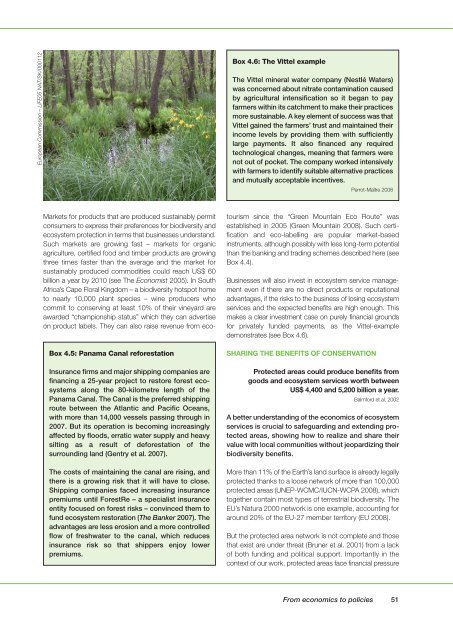Interim Report - TEEB
Interim Report - TEEB
Interim Report - TEEB
Create successful ePaper yourself
Turn your PDF publications into a flip-book with our unique Google optimized e-Paper software.
European Commission – LIFE05 NAT/SK/000112<br />
Box 4.6: The Vittel example<br />
The Vittel mineral water company (Nestlé Waters)<br />
was concerned about nitrate contamination caused<br />
by agricultural intensification so it began to pay<br />
farmers within its catchment to make their practices<br />
more sustainable. A key element of success was that<br />
Vittel gained the farmers’ trust and maintained their<br />
income levels by providing them with sufficiently<br />
large payments. It also financed any required<br />
technological changes, meaning that farmers were<br />
not out of pocket. The company worked intensively<br />
with farmers to identify suitable alternative practices<br />
and mutually acceptable incentives.<br />
Perrot-Maître 2006<br />
Box 4.5: Panama Canal reforestation<br />
Insurance firms and major shipping companies are<br />
financing a 25-year project to restore forest ecosystems<br />
along the 80-kilometre length of the<br />
Panama Canal. The Canal is the preferred shipping<br />
route between the Atlantic and Pacific Oceans,<br />
with more than 14,000 vessels passing through in<br />
2007. But its operation is becoming increasingly<br />
affected by floods, erratic water supply and heavy<br />
silting as a result of deforestation of the<br />
surrounding land (Gentry et al. 2007).<br />
The costs of maintaining the canal are rising, and<br />
there is a growing risk that it will have to close.<br />
Shipping companies faced increasing insurance<br />
premiums until ForestRe – a specialist insurance<br />
entity focused on forest risks – convinced them to<br />
fund ecosystem restoration (The Banker 2007). The<br />
advantages are less erosion and a more controlled<br />
flow of freshwater to the canal, which reduces<br />
insurance risk so that shippers enjoy lower<br />
premiums.<br />
Markets for products that are produced sustainably permit<br />
consumers to express their preferences for biodiversity and<br />
ecosystem protection in terms that businesses understand.<br />
Such markets are growing fast – markets for organic<br />
agriculture, certified food and timber products are growing<br />
three times faster than the average and the market for<br />
sustainably produced commodities could reach US$ 60<br />
billion a year by 2010 (see The Economist 2005). In South<br />
Africa’s Cape Floral Kingdom – a biodiversity hotspot home<br />
to nearly 10,000 plant species – wine producers who<br />
commit to conserving at least 10% of their vineyard are<br />
awarded “championship status” which they can advertise<br />
on product labels. They can also raise revenue from ecotourism<br />
since the “Green Mountain Eco Route” was<br />
established in 2005 (Green Mountain 2008). Such certification<br />
and eco-labelling are popular market-based<br />
instruments, although possibly with less long-term potential<br />
than the banking and trading schemes described here (see<br />
Box 4.4).<br />
Businesses will also invest in ecosystem service management<br />
even if there are no direct products or reputational<br />
advantages, if the risks to the business of losing ecosystem<br />
services and the expected benefits are high enough. This<br />
makes a clear investment case on purely financial grounds<br />
for privately funded payments, as the Vittel-example<br />
demonstrates (see Box 4.6).<br />
SHARING THE BENEFITS OF CONSERVATION<br />
Protected areas could produce benefits from<br />
goods and ecosystem services worth between<br />
US$ 4,400 and 5,200 billion a year.<br />
Balmford et al. 2002<br />
A better understanding of the economics of ecosystem<br />
services is crucial to safeguarding and extending protected<br />
areas, showing how to realize and share their<br />
value with local communities without jeopardizing their<br />
biodiversity benefits.<br />
More than 11% of the Earth’s land surface is already legally<br />
protected thanks to a loose network of more than 100,000<br />
protected areas (UNEP-WCMC/IUCN-WCPA 2008), which<br />
together contain most types of terrestrial biodiversity. The<br />
EU’s Natura 2000 network is one example, accounting for<br />
around 20% of the EU-27 member territory (EU 2008).<br />
But the protected area network is not complete and those<br />
that exist are under threat (Bruner et al. 2001) from a lack<br />
of both funding and political support. Importantly in the<br />
context of our work, protected areas face financial pressure<br />
From economics to policies<br />
51

















